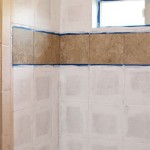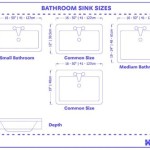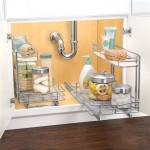Here's an article on installing bathroom vessel sinks, written in a clear, informative manner with the requested tags:
Installing a Bathroom Vessel Sink: A Comprehensive Guide
A bathroom vessel sink, also known as a bowl sink, is a stylish and increasingly popular alternative to traditional drop-in or undermount sinks. These sinks sit directly atop the countertop, creating a modern and visually striking focal point in the bathroom. While the installation process is generally straightforward, it requires careful planning and attention to detail to ensure proper functionality and prevent leaks. This article provides a comprehensive guide to installing a bathroom vessel sink, covering all the necessary steps from preparation to completion.
Before commencing the installation, careful consideration should be given to the height of the countertop and the sink. The combined height of the countertop and vessel sink should allow for comfortable use, typically ranging between 31 and 36 inches from the floor. This ergonomic consideration is crucial for preventing strain and ensuring a positive user experience. Failing to account for this can result in an inconvenient and uncomfortable setup.
The selection of the correct faucet is also a critical step. Vessel sinks require either a tall vessel faucet or a wall-mounted faucet. A standard faucet will likely be too short to reach over the rim of the sink. Tall vessel faucets are designed with an extended spout to accommodate the increased height, while wall-mounted faucets offer flexibility in placement and style. The faucet finish should coordinate with the sink and other bathroom fixtures to maintain a cohesive aesthetic.
Key Point 1: Preparing for Installation
The initial phase involves gathering the necessary tools and materials. Essential tools include a measuring tape, pencil, drill with appropriate drill bits (including a hole saw), level, plumber's putty, silicone sealant, adjustable wrench, basin wrench, and safety glasses. Material requirements encompass the vessel sink, chosen faucet, drain assembly (including the tailpiece and pop-up drain), supply lines (if replacing existing ones), and possibly a mounting ring for the sink.
The existing countertop must be prepared to accommodate the vessel sink and faucet. This typically involves drilling holes for the drain and faucet. The sink manufacturer's instructions will specify the required hole diameters and locations. Accurate measurements and careful drilling are paramount to prevent errors that could damage the countertop. Using a hole saw appropriate for the countertop material is crucial for creating clean, accurate holes.
Prior to drilling, it is highly recommended to create a template based on the manufacturer’s specifications. This template serves as a guide, ensuring accurate placement of the holes. Securely attach the template to the countertop using tape or clamps to prevent movement during the drilling process. Drilling should be performed slowly and steadily to avoid chipping or cracking the countertop material. For delicate materials like granite or marble, using a diamond-tipped hole saw and applying water during drilling can help prevent damage.
After drilling, thoroughly clean the countertop surface around the holes to remove any debris or dust. This will ensure a proper seal when installing the sink and faucet. Inspect the holes for any rough edges or imperfections and smooth them out with sandpaper or a file if necessary. This step is particularly important for preventing leaks and ensuring a clean, professional finish.
Key Point 2: Installing the Vessel Sink and Faucet
The drain assembly is usually installed first. Apply a thin bead of plumber's putty around the underside of the drain flange where it will contact the sink. Insert the drain flange into the drain opening from the top of the sink. From underneath the sink, attach the rubber washer, cardboard washer, and locknut to the drain tailpiece. Tighten the locknut securely, but not excessively, using an adjustable wrench to create a watertight seal. Remove any excess plumber's putty that squeezes out from around the drain flange. Ensure the pop-up drain mechanism is functioning smoothly before proceeding.
Next, carefully position the vessel sink over the drain opening on the countertop. Some vessel sinks may require a mounting ring, which is designed to provide a stable base and prevent the sink from rocking. If using a mounting ring, place it on the countertop before positioning the sink. Align the sink properly and gently press down to ensure it is securely seated. Check the sink's alignment with a level and make any necessary adjustments.
The faucet installation typically follows the manufacturer's instructions. Insert the faucet through the pre-drilled hole in the countertop. From underneath the countertop, attach the mounting hardware, which usually includes washers and locknuts. Tighten the mounting hardware securely using an adjustable wrench. Ensure the faucet is properly aligned and stable before proceeding. Connect the supply lines to the faucet according to the manufacturer's instructions. Use Teflon tape on the threaded connections to prevent leaks.
After connecting the supply lines, carefully turn on the water supply valves to check for leaks. Inspect all connections, including the drain assembly and faucet connections. If any leaks are detected, tighten the connections further or disassemble and reapply Teflon tape or plumber's putty as needed. It's critical to address even minor leaks promptly to prevent potential water damage.
Key Point 3: Plumbing Connections and Leak Testing
Connecting the drain tailpiece to the existing P-trap is a crucial step. The P-trap is designed to prevent sewer gases from entering the bathroom through the drain. If the existing P-trap is not properly aligned, it may be necessary to adjust or replace it. Use appropriate fittings and couplings to ensure a secure and leak-proof connection. Apply Teflon tape to all threaded connections before tightening.
After connecting the drain, run water into the sink to test the drain's functionality. Check for any leaks around the drain connections and the P-trap. If leaks are detected, tighten the connections or disassemble and reapply Teflon tape or plumber's putty as needed. Ensure the water drains freely and that there are no obstructions in the drainpipe.
Finally, inspect all connections one last time to ensure they are secure and leak-free. Clean up any excess plumber's putty or silicone sealant. Allow the sealant to cure completely according to the manufacturer's instructions before using the sink. Dispose of any waste materials properly and clean the surrounding area.
Proper disposal of waste materials is environmentally responsible. Recycle materials whenever possible. Dispose of hazardous materials, such as leftover sealant, according to local regulations. A clean and organized work area contributes to a professional and safe installation.
Maintaining a clean vessel sink enhances its aesthetic appeal and prolongs its lifespan. Regularly wipe down the sink with a soft cloth and mild detergent to remove soap scum and water spots. Avoid using abrasive cleaners, which can scratch the surface of the sink. Consider using a polishing compound specifically designed for the sink material to restore its shine and luster.
In conclusion, installing a bathroom vessel sink is a manageable project for homeowners with basic plumbing skills. Thorough preparation, careful execution, and meticulous attention to detail are essential for achieving a successful installation. By following these guidelines, homeowners can enhance the aesthetic appeal and functionality of their bathrooms with a stylish and modern vessel sink.

Info Center How To Install A Vessel Sink Sinks Gallery

Vessel Sinks A Complete Guide Roomhints

How To Install A Vessel Sink

How To Install A Vessel Sink

How To Install A Vessel Sink Faucet

How To Install A Vessel Sink Faucet

Vessel Sinks A Complete Guide Roomhints

How To Install A Vessel Sink Faucet

Info Center How To Install A Vessel Sink Sinks Gallery

How To Install A Vessel Sink
Related Posts







